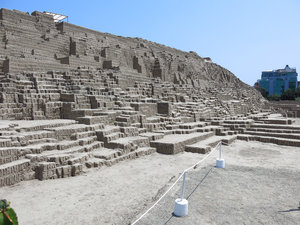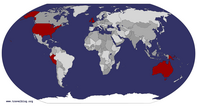Advertisement
Published: March 15th 2015

 Huaca Pucllana
Huaca Pucllana
The pre-Incan adobe ruins in the middle of Lima.No, I didn’t misspell the title.
When I last updated, we had just arrived in Lima after several adventure-packed days in Cusco. I’m currently sitting at home in sunny Bourbonnais, Illinois, but I would be remiss if I didn’t finish a final blog post detailing my time spend in Lima, Peru.
La Ciudad Grande Lima is big. Bigger than Chicago. If you’re a consistent reader of this blog, you will know that I do not like big cities. Contrarily, my two traveling partners LOVE big cities. We took a taxi from the airport to our hostel and I just looked out the window at all of the traffic, huge buildings, flashing lights, and droves of people everywhere and I immediately wanted to go back to Cusco – the cultural, scenic, slower-moving, smaller city we had just left. Within an hour of being at the bustling hostel in Lima, I had already planned my escape, much like breaking out of prison, to visit an area outside of the city.
The first day, Zach, Travis, and I visited Huaca Pucllana – a site of pre-Inca ruins located just a 15 minute walk from our hostel in the middle of

 Best Meal Ever
Best Meal Ever
Tenderloin steaks on the cooking stone: beef (left), lamb (middle), and alpaca (right).town. This site was is to a great pyramid constructed mostly by the Lima people around 500 AD. Every 15-20 years the Lima people would make a human sacrifice of a young noble girl and add another layer of adobe bricks on the pyramid, making it reach higher into the sky. These sacrifices were often dismembered and then placed in tombs, many of which have been excavated by archaeologists in the last 30 years. One of the amazing things about Huaca Pucllana is how intact things are, considering the fact that all of the structures are made from adobe, which is just baked clay. This is explained simply by the fact that Lima is located in the desert. I don’t use the word “desert” as a hyperbole – the city gets an average of 6.4 mm – just over a quarter inch of rain per year. Thus, structures like Huaca Pucllana don’t quickly erode.
The next day we travelled to the historic district of downtown Lima. Here is La Plaza Mayor surrounded by the Government Palace, Cathedral of Lima, Archbishop's Palace of Lima, the Municipal Palace, and the Palace of the Union. Much like Buckingham Palace in
London, at the Government Palace in Lima, there is a daily Changing of the Guard Ceremony. This consisted of two groups of armed guards in ceremonial dress accompanied by an official band that played Carmina Burana as the guards marched around the palace square.
There are two big churches in the downtown that you can tour – Catedral de Lima, and the Monastery of San Francisco. Opting to save money, Zach and I toured the Monastery, as it only cost us slightly over $1 USD. I wish I could upload pictures of this beautiful building, but photographs are not allowed inside. There is an amazing wooden dome, a beautiful library with books from the 16
th to the 20
th century, fresco-filled cloisters surrounding a courtyard, and many, many more ornate rooms and chambers. In one of the chambers, there is a fresco of a “Peruvianized” The Last Supper, in which the table is loaded with guinea pig (cuy – a traditional Peruvian dish), chilies, and potatoes. Beneath the church is located catacombs in which approximately 25,000 people were buried. Archaeologists have excavated some of this area, but much of it remains unexplored for fear of compromising

 Anticuchos
Anticuchos
Marinated and grilled beef heartthe foundation of the building. In certain parts of the catacombs, you can see thousands of bones, mostly femurs and skulls, lined up next to each other.
For my final day in Peru, I took a bus outside of town to the ruins of Pachacamac. Never mind the fact that the bus dropped me off about three kilometers past my destination and that I wandered around for a few hours because of the inaccurate directions given to me by locals. Oh, and this was straight up in the middle of the desert. All the sudden this little town ended and I walked beside the highway with sand as far as the eye could see in both direction. The cacti growing along one side of the road completed the aesthetics. I made it to the Pachacamac archeological site nonetheless. Pachacamac is similar to Huaca Pucllana, in the many of the ruins are pre-Inca. However, Pachacamac is much larger and was more culturally significant back in the day. There is located the second most important temple in the Incan Empire, El Templo del Sol (the largest and most important Incan temple is Qorikanchka, which we visited in Cusco). This archeological site

 Goverment Palace
Goverment Palace
Located in La Plaza Mayorhad many workers restoring the ruins, and I was one of only a handful of tourist that I saw there the entire day – it was a nice reprieve from the madness that is downtown Lima.
Comida Maravillosa For me, the highlight of this trip was Machu Picchu; without a doubt. The second greatest thing was the food. I am not one to eat out at restaurants often, but in Peru I ate out oftentimes twice a day because it was so cheap! I will now digress into telling you part of my week’s diet:
Alpaca steak – this is more or less a tourist entrée, but it was delicious nonetheless. It was served rare on a piping hot cooking stone, so that I could cook it to my satisfaction whilst sitting at the table. Much of our Peruvian meals were complemented by multiple types of sauce. The steaks came with four dipping sauces, the best of which were butter with some type of herb, and a picante chili sauce.
Ceviche – this dish is classic Peruvian seafood. It consists of raw seafood (usually white fish) that is cured in lemon
juice and served mixed with onions and some light spices. It’s not cooked with heat at all, so you could think of it kind of like Peruvian sushi. So good.
Lomo saltado – beef strips marinated in soy sauce, vinegar, and spices then stir-fried with onions and tomatoes and mixed with French fries before serving. It’s usually paired with rice. This dish came to Peru from Chinese immigrants, and it very similar to some Chinese stir-fry (minus the French fries).
Anticuchos – marinated beef heart grilled on a skewer. This was my second favorite meal (after the alpaca steak). The meat was so flavorful and had great texture – it was fibrous but not chewy.
Picarones – a classic desert often paired with anticuchos, picarones are made principally with pumpkin and sweet potato flour. They are almost identical to onion rings in appearance, as they are deep fried, but are much sweeter and served with a honey-fig syrup.
Papa a la Huancaína – a boiled yellow potatoes served in Huancaína sauce (a spicy, creamy, yellow sauce).
Cuy – guinea

 Catacombs of San Francisco
Catacombs of San Francisco
Many human skulls and femurs as arranged by archaeologists in the catacombs beneath the San Francisco Monastery.pig. This is the one Peruvian dish I did not have time to try. It’s definitely on the list for next time. Cuy used to be reserved for ceremonial banquets, but is now a food that everyone enjoys on most any occasion (Peruvians consume about 65 million guinea pigs each year). It can be served fried (chactado), broiled (asado), or roasted (al horno). I hear they’re delicious, plus they’re low in fat and cholesterol.
Chicharrónes – fried pork rinds. Deep fried fat; of course they’re good.
Chicha morada – a dark purple drink that is made from purple corn (maiz), often with added lemon juice and other grains. Chicha morada is non-alcoholic and is kind of like a noncarbonated soft drink. Chicha de jora is a type of corn beer that is allegedly made by women chewing corn into a paste, then spitting it out and letting it ferment. Thankfully, no one was selling that on the streets of Lima.
Coca – these leaves from a tree could fill a whole blog entry themselves. The only way that I

 Inca Kola
Inca Kola
Popular Peruvian soft drink.tried them was in tea (mate de coca), and by themselves (you chew on the leaves and swallow the saliva). They have been chewed since pre-Inca times as a source of energy, used as an anesthetic for trepanation (drilling holes in the skull), are used in the production of Coca-Cola, and are the precursor of cocaine.
Inca Kola – a popular soft drink. It is bright yellow and tastes EXACTLY the same as Irn Bru – an orange soft drink popular in Scotland. The taste is like bubble gum with a very slight citrus flavor.
Other Anecdotes: The hostel in which we stayed, Pariwana, is directly across the street from Kennedy Park (named for JFK). This part is home to AT LEAST 50 stray cats that mill around. People bring cat food to feed them and sit and pet them. I sat down on a bench in this park and a small cat jumped up on my lap and immediately curled up and went to sleep. They’re definitely not shy.
Peruvians aren’t the best at giving directions, in my experience. I got lost several different times and asked for directions. The
people are nice about it, but they just start listing street names and making sweeping gestures with their hands. I will point in a direction and ask if my destination is this way, and you can hardly get a straight answer. Over the course of my week, I asked over 20 people for directions, and only two of them gave me accurate and helpful advice.
And so ends my Peruvian travels. I will be uploading more pictures in the next 24 hours, so make sure to revisit my two previous blog posts to see them. As always, thanks for reading, feel free to subscribe for email notifications, and stay tuned for June when I return to Scotland and Ireland!
Advertisement
Tot: 0.12s; Tpl: 0.014s; cc: 9; qc: 23; dbt: 0.0645s; 1; m:domysql w:travelblog (10.17.0.13); sld: 2;
; mem: 1.1mb


















